Standard [CURRENT]
ASTM D 6831:2025
Standard Test Method for Sampling and Determining Particulate Matter in Stack Gases Using an In-Stack, Inertial Microbalance
- Publication date
- 2025
- Original language
- English
- Pages
- 18
- Publication date
- 2025
- Original language
- English
- Pages
- 18
- DOI
- https://dx.doi.org/10.1520/D6831-25
Product information on this site:
Quick delivery via download or delivery service
Buy securely with a credit card or pay upon receipt of invoice
All transactions are encrypted
Short description
1.1 This test method describes procedures for determining the mass concentration of particulate matter in gaseous streams using an automated, in-stack test procedure. This test method, which employs an in-situ, inertial microbalance, is based on inertial mass measurement using a hollow tube oscillator. This test method describes the design of the apparatus, operating procedure, and the quality control procedures required to obtain results of a known precision and accuracy. 1.2 This test method is suitable for collecting and measuring filterable particulate matter concentrations in the ranges 0.2 mg/m3 and above taken in effluent ducts and stacks. 1.3 This test method may be used for calibration of automated monitoring systems (AMS). If the emission gas contains unstable, reactive, or semi-volatile substances, the measurement will depend on the filtration temperature. This test method may be more applicable than out-stack methods for the calibration of automated monitoring systems. 1.4 This test method can be employed in sources having gas temperature up to 200 °C (392 °F) and having gas velocities in the range of 3 m/s to 27 m/s. 1.5 This test method may not be applicable to sampling gas streams that contain fluoride, or other reactive species having the potential to react with or within the sample train. Users should validate this test method for such applications to ensure applicability and ability to meet data quality objectives. 1.6 Appendix X1 provides procedures for assessment of the spatial variation in particulate matter (PM) concentration within the cross section of a stack or duct test location to determine whether a particular sampling point or limited number of sampling points can be used to acquire representative PM samples. 1.7 Appendix X2 provides procedures for reducing the sampling time required to perform calibrations of automated monitoring systems where representative PM samples can be acquired from a single sample point and certain other conditions are met. 1.8 The values stated in SI units are to be regarded as standard. The values given in parentheses are mathematical conversions to inch-pound units that are provided for information only and are not considered standard. 1.9 Subsections 7.6 , 7.7 , and 13.2 state the use of mercury barometers and thermometers. Users should consider use of electronic barometers and non-mercury alternatives to thermometers in performance of this test method. 1.10 Warning- Mercury has been designated by many regulatory agencies as a hazardous substance that can cause serious medical issues. Mercury, or its vapor, has been demonstrated to be hazardous to health and corrosive to materials. Use caution when handling mercury and mercury-containing products. See the applicable product Safety Data Sheet (SDS) for additional information. The potential exists that selling mercury or mercury-containing products, or both, is prohibited by local or national law. Users must determine legality of sales in their location. 1.11 This standard does not purport to address all of the safety concerns, if any, associated with its use. It is the responsibility of the user of this standard to establish appropriate safety, health, and environmental practices and determine the applicability of regulatory limitations prior to use. 1.12 This international standard was developed in accordance with internationally recognized principles on standardization established in the Decision on Principles for the Development of International Standards, Guides and Recommendations issued by the World Trade Organization Technical Barriers to Trade (TBT) Committee.
ICS
07.100.01
DOI
https://dx.doi.org/10.1520/D6831-25
Also available in
Loading recommended items...
Loading recommended items...
Loading recommended items...
Loading recommended items...

